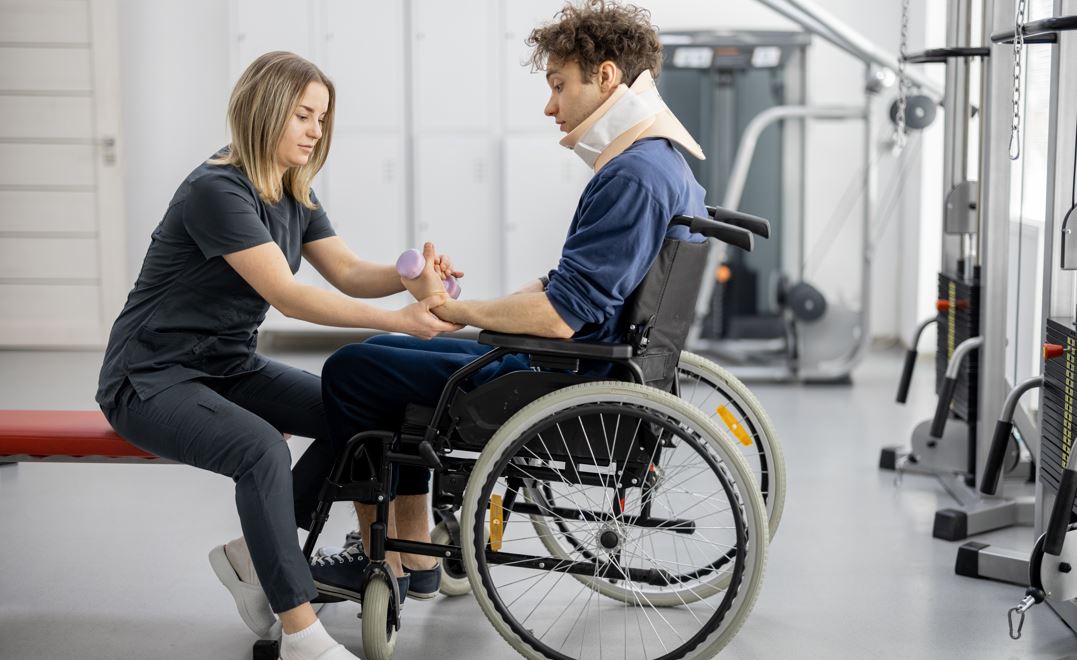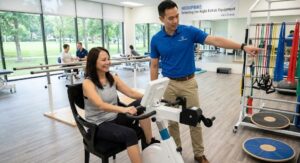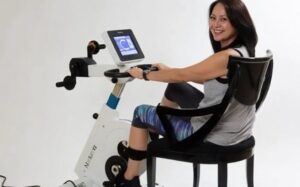
Recovering from an injury or surgery can be a challenging journey, but modern technology is helping make the process a lot smoother. Wheelchair cycling, particularly with active-passive cycle trainers, is gaining recognition as an effective rehabilitation tool. This method of rehabilitation allows patients to safely restore strength, improve circulation, and regain mobility, even when they are still in the early stages of recovery. Active-passive trainers are making a big difference in healthcare settings by providing a low-impact, versatile option for patients recovering from various conditions.
What Is Wheelchair Cycling for Rehabilitation?
Wheelchair cycling for rehabilitation involves using specially designed equipment, such as an active-passive cycle trainer, that enables patients in wheelchairs to engage in cycling exercises. The active-passive cycle trainer provides a unique feature where the patient can cycle manually (active mode) or have the device assist with the pedaling motion (passive mode), making it accessible for individuals with varying levels of strength and mobility.
The primary goal of wheelchair cycling for rehabilitation is to promote muscle recovery, improve cardiovascular health, and prevent the negative effects of prolonged immobility. This exercise can be done from the comfort of a wheelchair, making it particularly suitable for patients who have difficulty standing or walking due to their injury or surgery.
How Active-Passive Cycle Trainers Aid Recovery
Did you know? The Active-Passive Cycle Trainer by MedUpBike is a great way to support recovery after surgery or injury, helping patients regain strength in a comfortable, non-weight-bearing way.
Active-passive cycle trainers offer multiple benefits for patients in rehabilitation, especially in healthcare settings. Here are some key ways these trainers contribute to recovery:
1. Improved Circulation and Cardiovascular Health
Injury or surgery can significantly reduce a person’s physical activity level, leading to decreased blood circulation and increased risk of blood clots. Active-passive cycle trainers stimulate circulation, helping to maintain blood flow, particularly in the legs, even when the patient is unable to move independently. This circulation boost aids in the healing process and can reduce swelling, stiffness, and discomfort.
2. Muscle Strength Restoration
One of the most critical aspects of recovery after surgery or injury is regaining lost muscle strength. The passive mode on the cycle trainer assists with pedal movement, allowing patients to experience the benefits of cycling without needing to exert full effort. This is an excellent way to gradually build strength and mobility. As the patient’s strength improves, they can switch to the active mode, cycling on their own, which encourages further muscle development.
3. Reduced Risk of Muscle Atrophy
Extended periods of inactivity following surgery or injury can lead to muscle atrophy (weakening or shrinking of muscles). Using an active-passive cycle trainer regularly helps combat this issue by keeping muscles engaged, even if the patient can’t fully pedal on their own in the early stages of recovery. By moving the muscles through a full range of motion, the trainer can help prevent atrophy and encourage faster recovery.
4. Pain Relief Through Gentle Motion
Gentle, repetitive movement can help reduce pain and stiffness in joints and muscles. Active-passive cycle trainers allow patients to experience these benefits without putting undue stress on the body. This motion helps lubricate the joints and ease tension in the muscles, leading to reduced pain and improved comfort during recovery.
5. Mental Well-Being and Motivation
Rehabilitation can be a mentally and emotionally taxing process. The sense of accomplishment gained from using a cycle trainer and seeing physical progress can provide motivation and a positive outlook during recovery. Active-passive trainers also offer patients a sense of autonomy, as they can cycle independently or with minimal assistance.
Who Can Benefit from Wheelchair Cycling for Rehabilitation?
Patients of various backgrounds can benefit from wheelchair cycling for rehabilitation, especially in settings such as hospitals, rehabilitation centers, and long-term care facilities. It’s particularly useful for individuals recovering from:
- Orthopedic Surgery (e.g., joint replacement, fractures)
- Stroke Recovery
- Spinal Cord Injuries
- Neurological Disorders (e.g., multiple sclerosis, Parkinson’s disease)
- Amputations
- Muscle Weakness and Atrophy due to prolonged bed rest or immobility
Healthcare providers can tailor the use of cycle trainers to meet the needs of individual patients, whether they require full assistance or are capable of performing the activity with limited support.
Why Healthcare Facilities Are Turning to Active-Passive Trainers
Active-passive cycle trainers are increasingly being adopted in healthcare settings for rehabilitation due to their versatility, ease of use, and effectiveness. Healthcare professionals value these devices for their ability to accommodate patients with a wide range of mobility and strength levels. Furthermore, the trainers allow for progressive rehabilitation, ensuring that patients don’t overexert themselves while still gaining the benefits of exercise.
These trainers can be used in both acute and chronic care settings, as well as in outpatient rehabilitation programs. Their adaptability makes them a useful tool for both short-term recovery and long-term mobility maintenance.
The Road to Recovery: Cycling Towards Health
Rehabilitation doesn’t have to be a long, painful road. Wheelchair cycling with the help of active-passive cycle trainers can provide significant support for those recovering from surgery, injury, or illness. Whether it’s restoring muscle strength, improving circulation, or simply offering a low-impact way to stay active, this form of rehabilitation has a lot to offer.




